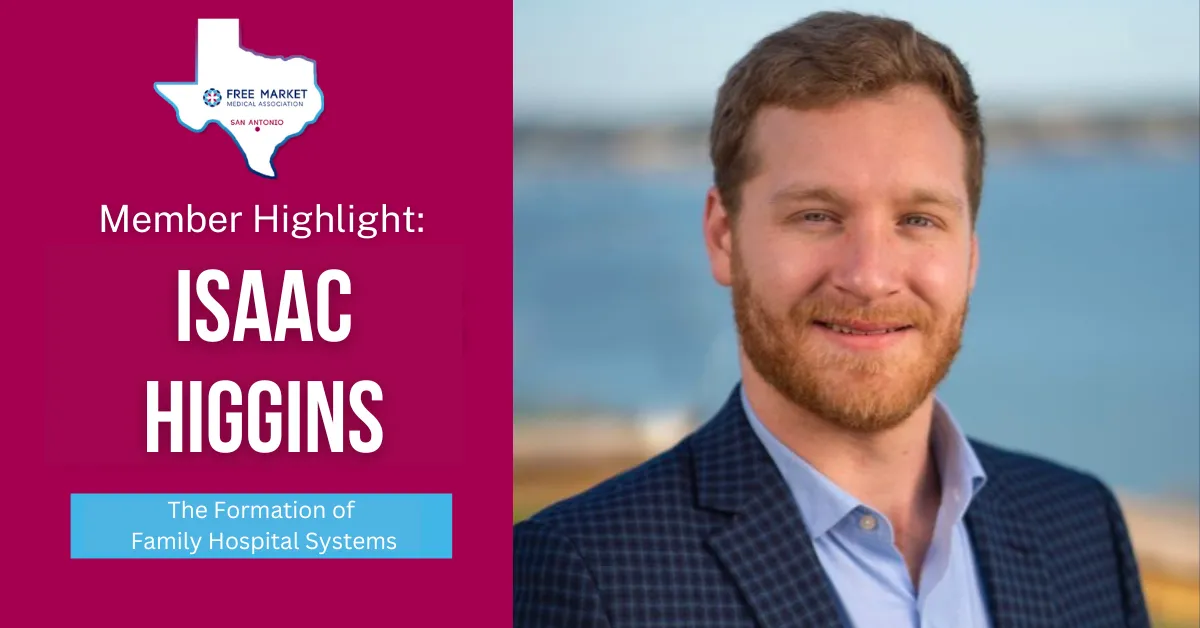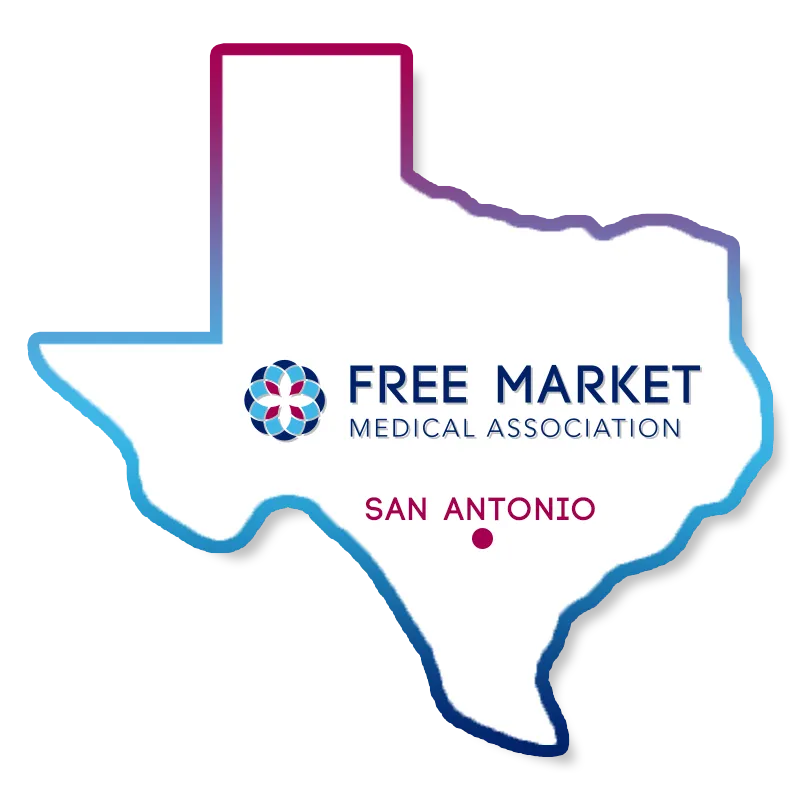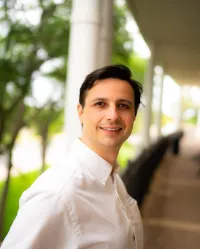Contact Us
sanantonio@fmma.org
Follow Us:
Our Blogs

San Antonio FMMA Member Highlight: Isaac Higgins
Member Highlight: Isaac Higgins
The purpose of our member highlights is to shine a spotlight on outstanding individuals who form part of a groundbreaking network as members of the revolutionary San Antonio Free Market Medical Association. For our December 2022 issue, we chose to highlight Isaac Higgins, CEO and Founder of Family Hospital Systems.
Where do you come from? We’re always interested in hearing about people’s backgrounds and childhood experiences.
I finished up my high school here in Austin, Texas. I went off to the University of Alabama to get my Business Management degree, I went there on an academic scholarship. I ended up in the Honors program and went through several different classes really not knowing what I liked to do, like most people that are graduating the high school system and going into college. While there, I started exploring different avenues as far as getting into working with small business owners. I worked with some large corporations at the time doing marketing for them as well. What I really gravitated to was building websites and learning how to operate those, and doing things like Shopify, drop shipping, etc. Really understanding how to do lead generation, I really gravitated towards the digital aspects of that. So, combined with working with groups like Anheuser-Busch in college where I was out doing face-to-face marketing for Bud Lite and building digital marketing websites, I was able to develop some soft skills I brought home with me when I graduated in 2017.
How did your family business start?
At the time, my father was an ER physician working in a Level 1 trauma center over in Abilene, Texas really getting burned out on emergency medicine. He was seeing anywhere between 50-60, sometimes 70 patients a shift, having an average of about 5 minutes with each one before he had to move on to the next room. He was getting burned out on how medicine was practiced, so when we made the transition from Abilene to Austin in 2011, he was really contemplating quitting medicine and going into building car washes and storage units. But, through that transition, he came across a new opportunity in a new industry that was starting to emerge called “freestanding emergency rooms,” which is simply an emergency department that is detached from a hospital site. You can provide 27/4 emergency care, it comes fully equipped with emergency room physicians, imaging, labs, full-on nurse staff, everything you would find in a traditional emergency department.
When we founded our first emergency room, we actually took an old Suzuki car dealership and renovated it into the first family ER. He and two partners were finally able to practice medicine the way that they saw fit, they weren’t dictated by some administration on ‘X’ amount of tests or ‘Y’ amount of scans that they had to do per month to meet quota. They finally had the flexibility to provide direct care to the community. However, the only frustration they had was working with health insurance, whereas with a small provider or small organization you can’t really sit down with large health insurance systems and get negotiated rates, it’s just not possible. We’ve always been working as these out of network facilities but trying to do right by the patient; by not sending them to collections, no balance billing, no surprise bills, and making sure that the insurance companies actually pay for what they’re legally required to pay.
Out of that frustration, we created a brand new program that involved direct primary care and we used our new company called, Cage Free Care, that operates as a direct primary care network to incorporate all of the services that we do in our facilities, from the emergency room to the primary care to the imaging to the labs in a monthly subscription. We’ve been working with that program now for a little over 3 or 4 years and have been able to successfully implement this with employer groups, providing individuals and families direct access to our emergency department all for a monthly subscription cost of $125 a month where they have all inclusive access with no copays and no deductibles, it’s just direct healthcare. Through the evolution of our company, we grew into offering various different service lines in family hospital systems outside of the emergency department where it included primary care, outpatient imaging, outpatient labs, and bundled surgical cases. We also have a big passion for the recovery community where we work directly with a company called, Rise Recovery, to help those individuals that are suffering from substance abuse go through a short term medical stabilization at one of our facilities that will help them get off of things like methadone, suboxone, heroin, and alcohol, where we medical screen and stabilize them to move on to the next journey of recovery and assign them a case manager. We have a big passion as a provider first organization to find needs in our community and fill those needs with services.
That is awesome. You also have emergency room services, direct primary care, and you’re starting to grow a hospital system based on these principles?
As of right now we are a hybrid practice where we do take commercial insurance and we take membership. Where we see the future of healthcare heading is a full cash price, full membership based program that really where insurance has kind of overreached dictating what kind of antibiotics we should be prescribing, we need to push back as a community to where health insurance is really designed for catastrophic needs… There is a place for health insurance, it’s just not the extreme that it is today. If I had it up to my way designing a perfect healthcare system for the United States, I would get rid of the need of having a high deductible health plan that is HSA qualified and have every American allowed to do a health savings account. Then, I would design a health insurance program that met those catastrophic needs and then gave a discount to those participating with direct primary care. That would be the perfect system in my mind.
I love that the ecosystem is starting to come out with all kinds of entrepreneurial approaches to solve this problem, ranging from something that works for an individual to something that works for companies who have more regulations to abide by. It is really an exciting time to be a part of this movement and I’m really impressed by the perfect trifecta that you guys have. Very often the people who design these things are not clinicians, don’t understand the business side or the marketing side, but it looks to me like you’ve really come up with a very interesting combination.
Thank you, I really do appreciate that. We’re just a small healthcare system founded by accident honestly. We had no intention of growing into a hospital based organization. We were just a bunch of doctors trying to provide healthcare to their community, saw a need and started trying to fill that need. Along the way we picked up a couple of things as far as recognizing that health insurance is an ever changing market. What was your grandma and grandpa's insurance is no more. The days of zero dollar deductible and low out of pocket maxes don’t really exist, and if they do you’re paying outwards of thousands of dollars a month to have access to that healthplan. So, healthcare and health insurance are on a tipping point where something’s got to change and entrepreneurs are coming out left and right with all of these great, fantastic ideas. I think that naturally as health insurance has become unaffordable, there are more solutions that are going to come out that meet the needs and demand of the community and the population that are trying to access healthcare affordably. So, we’re excited to be a part of that movement and look forward to working with other providers and organizations that want to do something different from the traditional status quo.
If you’re an employer looking for affordable healthcare, I really advice you to look at either a Health Rosetta or an open minded broker that can come in and not push the traditional status quo Blue Cross/Blue Shield plan that they have no incentive on driving cost down because they get paid on a percentage of the overall premium. So, really what you’re looking for is transparent brokers that do a fixed cost that can truly advise you on the best approach for you and your employees. And if you’re an individual looking for affordable access to care, look at direct primary care and a health share where you can get a discount and share with the community for anything that falls inside of that catastrophic need. There’s some really great options out there and I look forward to more coming out in the future.
What kind of skepticism do you usually face when discussing any of the new healthcare models you mentioned?
People are uncomfortable with change… Right now we’re in the early adoption phase where people… are forced to look at alternatives because they can’t afford a $2,000 a month health insurance premium. That’s another mortgage for most people so it’s this forced innovation that is happening in people being open to the idea of looking at these alternative healthcare models.
Really when we present the DPC model that includes our emergency room and imaging at the labs and everything that we do, people are skeptical of the price. They say, “How can you charge $50 a month for primary care and keep your doors open?” Healthcare as a whole really is not that expensive, it’s all the middle men and all the layers that have been built in between in a system that’s designed to inflate the cost of healthcare. When you remove all of those middle men and what is health insurance today, all of a sudden healthcare becomes a lot more affordable.
You’re based in Austin, correct?
We have six locations here in Austin, North Austin specifically. Two in Omaha, Nebraska. The way that we designed the Cage Free model was to be a network of like minded individuals and organizations that wanted to do something different as the biggest limitation to direct primary care as it stands today, especially in the employer groups, is the access or the geography component. If I’m a large employer and I have multi-city or multi-state employees, I love the idea of DPC. I need something that can bring it together to implement that solution, where we have a platform that unifies the billing process and the accessibility for the employees. We want to bring in those like minded individuals to deploy that solution in the employer market and then also meet the geography needs of the individuals and families that want to do something different from the traditional status quo.
Are you planning a location in San Antonio?
We are. As of right now we are in the works of finalizing the certificate of occupancy of an old freestanding emergency room that shut down a little while ago. It’s going to be in the Northwest San Antonio market where we are going to be opening up probably in the beginning of February or late March, sometime around that time frame.
Definitely send us an invitation for the ribbon cutting to that! So, what is one of the biggest obstacles that you’ve seen speaking of those agents that don’t like to see the cost inflation being fought?
The biggest obstacle is getting through the hurdle of the broker. Sometimes when you talk to an employer, there’s a previous relationship of 10 years, going in there and saying that the broker has not been doing right by you isn’t always the best approach. I like approaching the broker first and letting them know that “Hey, there is an alternative model. Have you thought about this? What are your voices of concern with doing something like this?” And if I get the feeling that the broker is not doing the best thing for the client at that point, then I talk to the employer and let them know that there is an alternative option out there and this is the path that they would have to take to achieve that. If they are open to something like that then I will step in and start helping advise on that plan or I’ll find a partner of mine that might be better suited for their needs to advise on. That’s really the biggest hurdle because the employer trusts typically the broker that’s been with them for years and if you go in and disrupt that relationship, it’s sometimes very difficult.
If we look at this situation from a human perspective, most brokers—this may not apply to all of them—but most brokers are victims of the system as well, right? They happen to have chosen a path where, in all frankness, they want to help but they have a system to work with. You have to be really understanding and educate yourself to see the big picture and break out of that limitation and work in different ways, but there are those brokers out there and they’re definitely a part of our network.
Absolutely. And the biggest thing is healthcare is not one size fits all. Everybody has specific needs, like you mentioned, sometimes brokers are taught one way and this is how things are and they don’t go outside of the box. My favorite thing is to take one of those brokers and convert them into a free market minded person.
How did you choose the name “Cage Free?” Are you a vegan?
No, I’m not a vegan but coming from Austin, Texas we thought, “Well, how can we create a catchy name that kind of resembles ‘Keep Austin Weird’ but also incorporates some of the good wellness aspects of cage free eggs for example.” Whenever we were sitting down designing this company, my father and I, we were thinking what kind of name could meet the needs of how the system is right now and bring that Austin quirkiness to it. We thought, “What is the system currently like?” There’s a bunch of providers and patients locked in a cage and insurance companies are sitting there dangling the keys laughing the entire way. We said, “Typically, cage free eggs are better for you and here we are providing a solution. We’re the key to your healthcare. Why not name it Cage Free Care?” Out of that, we designed a system that gives patients back the key to their own healthcare.
Tell me, what does the future look like for you and your ventures? Where do you see yourself in a year or 5 years?
I would like to start working with more like minded providers who are tired of the traditional health insurance system. That’s really my first and biggest goal is to help individual providers and organizations break free of the traditional status quo. From there, helping those providers by introducing them to employer organizations that want to do something different from their traditional health insurance plan and really kind of growing that in the state of Texas and beyond. If we look at Texas specifically, there are about 180 independently owned, freestanding emergency rooms throughout the state of Texas that all are suffering the same issues that we expressed today about being these small independent facilities where they don’t have the opportunity to sit down with large health insurance companies and get negotiated rates. They’re all looking for an alternative model and my goal and hope is to band those together to provide a unified solution to the employer market and to the individuals. Here in the state of Texas but then also growing that outside of the state into other areas like our Nebraska presence and other states and beyond.
To hear more from Isaac Higgins, make sure to watch the video interview, conducted by Shankar Poncelet, CEO of Shankx Web Development and a chapter leader of the San Antonio FMMA, below:
https://www.youtube.com/watch?v=MTaXnTdn7vs
About the San Antonio Free Market Medical Association
Organized in 2019, Roger Moczygemba, MD and Shankar Poncelet came together with the goal to lower the cost of healthcare in San Antonio through price transparency, reference-based pricing, and local connection.
The San Antonio FMMA recognizes the three pillars on which the national FMMA was founded by Jay Kempton and Dr. Keith Smith in 2014:
1. Price is not a product.
2. Value is mutually determined and requires transparent pricing and quality.
3. Cash is king, the equality of price is critical.
The FMMA connects buyers and sellers of healthcare, educating and motivating them to work together based upon a mutually beneficial relationship built on the pillars. To learn more, visit https://SanAntonioFMMA.org or contact sanantonio@fmma.org
This member highlight is brought to you by Shankx Web Development and Consulting. For more information, please visit https://shankx.com/

Follow Us
Follow Us
© Copyright 2025. San Antonio Free Market Medical Association. All rights reserved. Site by SHANKX.
